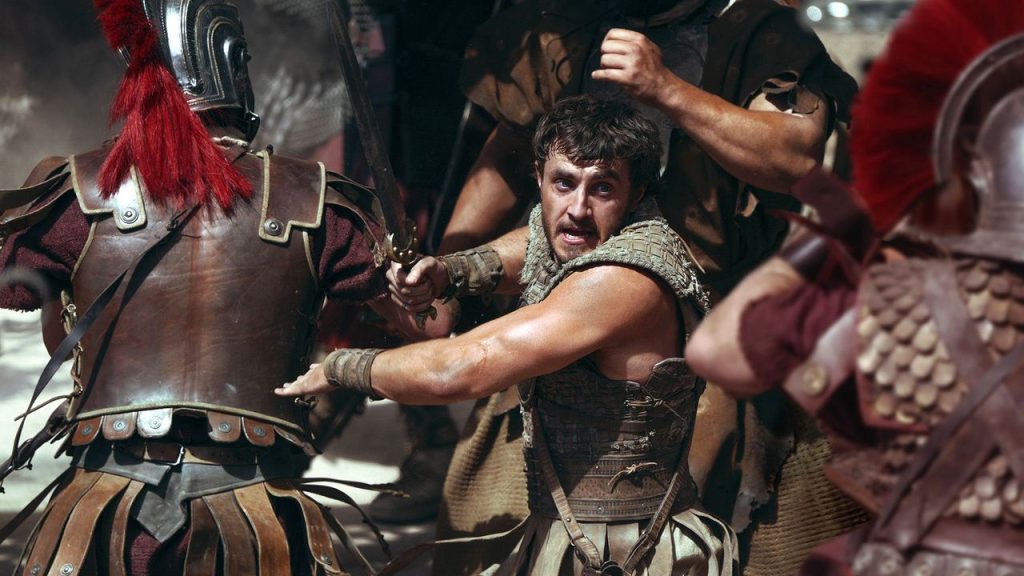Interview By Teresa Greco
More than two decades after Ridley Scott’s Gladiator brought ancient Rome thundering back to the forefront of modern cinema, the director returned with a sequel that feels as audacious in scale as it is timely in message. Gladiator II, released in November 2024, continues the legacy of the original while presenting a new portrait of masculinity, power, and perseverance in the face of empire.


The Brutality and Beauty of Ridley Scott’s Vision
In Scott’s own words, this is “the best thing I’ve ever made”—a bold declaration from a filmmaker whose work includes Alien, Blade Runner, and Thelma & Louise. “It’s full-bore, brutal action,” Scott told Empire Magazine, describing scenes that surpass even the original’s iconic battles. And yet, beneath the dust and blood of the Colosseum lies a contemplative narrative—one that explores legacy, identity, and the heavy burden of power.
A Legacy Reclaimed: The Journey of Lucius Verus
Gladiator II follows the story of Lucius Verus (Paul Mescal), the now-grown son of Lucilla and nephew to the late Emperor Commodus. In the aftermath of Maximus Decimus Meridius’s sacrifice at the end of the original film, Lucius was sent by his mother to live in Numidia for protection. But safety was fleeting. Captured and forced into slavery, Lucius rises through the ranks of the arena, his true identity hidden from those around him—including Lucilla, played once again by Connie Nielsen, who now stands on the other side of the imperial divide.
Irish actor Paul Mescal brings striking depth to the role of Lucius, his performance rooted in the same emotional nuance that has defined his career. Born on February 2, 1996, in Maynooth, Ireland, Mescal first gained international recognition for his BAFTA-winning turn in the BBC/Hulu series Normal People (2020), followed by critically acclaimed performances in The Lost Daughter (2021), Aftersun (2022)—which earned him an Academy Award nomination for Best Actor—and All of Us Strangers (2023). His transition into Gladiator II marks his debut in big-budget Hollywood filmmaking, a career pivot that has already commanded industry-wide attention.
Reflecting on his experience working with Ridley Scott, Mescal noted: “The gift that he gives actors beyond his kind of innate intuition with character is the world that he builds around you. Wherever your eye really looks, unless you’re looking down the lens of the camera, is probably period appropriate.”
This generational disconnect serves as the emotional spine of the film. Where Gladiator explored vengeance, Gladiator II unpacks exile, estrangement, and return. “We made an attempt to not feel slick,” Mescal said in a recent interview. “You’re feeling like their bodies are slowing down as they’re fighting… It’s more brutal. You’re feeling the fatigue.” There’s a palpable realism in both the action and the emotion.
Lucius’ journey is not one of rediscovering Rome but of redefining it. As a man born into power and raised in obscurity, his return is not simply to fight, but to reclaim a forgotten legacy.

Ancient Rome Comes to Life: The Grandeur of Production Design
Scott’s vision for Gladiator II is nothing short of monumental. With a reported production budget between $250 and $310 million, the film recreates the Roman Empire with an opulence rarely seen in contemporary cinema. Production designer Arthur Max reconstructed entire Roman districts in Morocco and Malta, while the costume department, led by Janty Yates and David Crossman, produced over 2,000 individual garments for the cast. Every tunic, breastplate, and cloak was handcrafted using ancient techniques and fine materials sourced across Europe.
Yet for all its splendour, the sequel never loses sight of its humanity. This is a film where generals wear embroidered leathers not just for spectacle, but as emblems of honour and identity. The tension between utility and ornament reflects a central theme: in Rome, as in the modern world, power is as much about image as it is about might.
The Architects of Empire: A Cast of Titans
The ensemble cast assembled for Gladiator II reads like a roll call of cinematic royalty. Mescal anchors the narrative with a performance that promises both physical intensity and inner complexity. Pedro Pascal joins as Marcus Acacius, a Roman general once trained by Maximus himself. In a departure from his typical roles, Pascal portrays a commander hardened by politics and war, a man whose convictions may mask deeper wounds.
Denzel Washington delivers a standout turn as Macrinus, a former slave turned arms dealer who now commands his own unit of imprisoned gladiators. “He wants to be emperor,” Washington has said. “And he’s willing to do anything to get there.” As a power broker of North African origin, Macrinus introduces a fresh dynamic into the imperial equation—a self-made kingpin with ambitions as grand as Rome itself.
And then there is Lucilla, once a tragic figure in the original film, now reimagined as a complex matriarch navigating her son’s reappearance and her allegiance to the Empire. Nielsen, returning to the role after more than 20 years, described the experience as “emotional, haunting, and thrilling.” Her performance, as much as Mescal’s, anchors the film’s moral ambiguity.
Masculinity Reimagined
If Gladiator presented a vision of masculinity defined by stoicism and sacrifice, Gladiator II interrogates those same ideals. In a recent editorial for The Guardian, critic Zoe Williams noted the contrast: “Where once Maximus represented raw, nearly singular masculine idealism, Mescal’s Lucius is thoughtful—a different hero for a different era.”
The film does not shy away from these evolutions. Scott has acknowledged that Mescal’s casting is meant to surprise audiences. Known for his quieter, emotionally nuanced roles, Mescal brings a softer but no less formidable presence to the Colosseum. His Lucius is not a warrior by nature but by necessity, and in this transformation lies the film’s most compelling arc.
A Cinematic Parallel to Our Times
Though set in the ancient world, Gladiator II feels rooted in the present. It deals with political unrest, cultural collision, and the looming collapse of empire. These aren’t distant ideas—they’re mirrors of the moment we’re in now, seen through the lens of history.
Scott has hinted that this may not be the end. “I’m already toying with ideas for Gladiator III,” he mused. If so, Gladiator II may serve not as a conclusion, but as a bridge—a testament to how great cinema can carry the past into the present, and elevate spectacle into storytelling.






